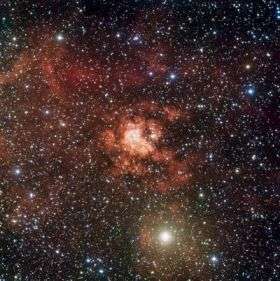A claret-colored cloud with a massive heart

(PhysOrg.com) -- Gum 29 is a huge region of hydrogen gas that has been stripped of its electrons (ionised) by the intense radiation of the hot young stars located at its centre. Astronomers call this an HII (pronounced "H-two") region, and this particularly stunning example stretches out across space for over 200 light-years. The name stems from the fact that it is the 29th entry in the catalogue published by Australian astronomer Colin Stanley Gum in 1955.
Embedded deep within the huge, nebulous expanse of Gum 29, the relatively little known cluster of Westerlund 2 is clearly seen in the centre of this image. The latest measurements indicate that it lies at a distance of some 26 000 light-years from Earth, placing it towards the outside edge of the Carina spiral arm of the Milky Way. The cluster's distance has been the subject of intense scrutiny in the past, as it is one of the parameters needed to understand this intriguing object. Westerlund 2 is very young too, with an age of only 1—2 million years.
Previous observations have shown that two stars to the bottom right of the cluster are true leviathans. Together they form what is known as a double system. The two stars have masses of 82 and 83 times that of our Sun and rotate around each other in approximately 3.7 days. They are amongst the most massive stars known to astronomers.
Detailed observations of this intriguing pair have also shown that they are both Wolf-Rayet stars. These are massive stars nearing the end of their lives, expelling vast quantities of material as their final swansong. Observations made in X-rays have subsequently shown that streams of material from each star continually collide, creating a blaze of X-ray radiation.
The image was obtained with the Wide Field Imager (WFI) camera attached to the 2.2-m Max-Planck/ESO telescope at ESO's La Silla observatory site in Chile. Located at an altitude of 2400 metres in the arid Atacama Desert, this observatory sits under some of the clearest and darkest skies on Earth. The WFI excels at studying the farthest depths of the Universe from this unrivalled vantage point.
Provided by ESO




















